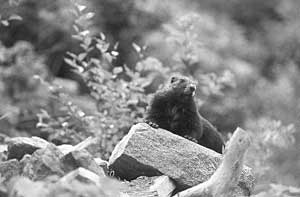Preparations for the release of two groups of marmots were made at the Tony Barrett Mount Washington Marmot Recovery Centre on Mount Washington. The Marmot Recovery Foundation (MRF), in partnership with the B.C. Ministry of Environment and BC Hydro, hopes to re-establish a self-sustaining colony of Vancouver Island marmots in the historic park.
Environment Minister Barry Penner participated in the historic release although weather conditions made it touch and go for a while. “This is an important part of the effort to restore Vancouver Island marmots to their rightful habitat,” said Penner. “I commend everyone involved in the project and I look forward to the day when one of Canada’s most endangered mammals is back up to a sustainable population in the wild.”
Strathcona Provincial Park is the largest area of protected marmot habitat on Vancouver Island and has been identified as a key area for the recovery of the species. Scientists are hopeful that survival in the park will be better there than in the southern ranges where predation continues to challenge survival of the wild population.
“It remains unclear why the Vancouver Island marmot disappeared from this area decades ago,” said MRF Executive Director Viki Jackson. “The habitat remains largely untouched and there are plenty of sub-alpine bowls with suitable vegetation for the marmots to eat. Released animals will be closely monitored to help us understand what may have gone wrong in the past.”
The ultimate goal of the recovery program is to have 400-600 animals surviving in three populations on Vancouver Island. The captive breeding program continues to do well with 60 pups born at our partner facilities at the Calgary and Toronto zoos, Mountain View Conservation & Breeding Centre and the Mount Washington Marmot Recovery Centre in 2007 but the numbers in the wild remain a challenge with an estimated 85-95 animals.
“The Vancouver Island marmot remains one of the rarest animals in the world but it’s encouraging when you remember that the entire wild population was less than 30 animals in 2003”, Jackson said. “Since that time we’ve increased the wild population and built up a robust captive population of around 160 marmots in addition to the 85-90 in the wild. It’s still very few animals when you consider other endangered species, like China’s Giant panda, number in the thousands”.
“With only 3 litters born in the wild last year – and released animals participating in 2 of those litters it’s easy to see the survival and success of the wild population depends on the introduction of these new animals”. Of the three litters born in the wild in 2007 one litter was to wild parents, one litter was to a wild male and captive-born female and one litter was to captive-born parents.
The Marmot Recovery Program is a unique partnership between the BC Government, landowners, Island Timberlands, TimberWest and Mount Washington Alpine Resort, the Toronto and Calgary Zoos, Mountain View Conservation & Breeding Centre, the Tony Barrett Mount Washington Marmot Recovery Centre and over 10,000 members of the public who have contributed to the Marmot Recovery Foundation, a charitable organization.
For more information or to make a donation to help save Canada’s endangered Vancouver Island Marmot visit www.marmots.org
